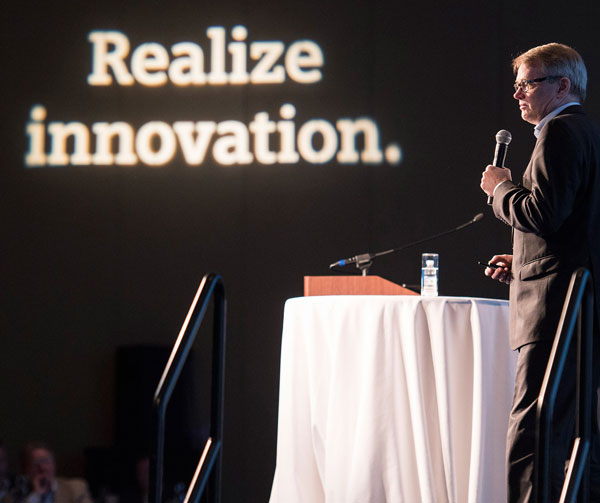
Dr. Horst J. Kayser, chief strategy officer, Siemens AG, presented the keynote focusing on digitalization: “The digital change constant.” Image courtesy of Siemens PLM Software.
September 15, 2015
Each year, Siemens PLM Software invites industry analysts and members of the press to an event designed to explain what is driving the development of the company’s software. This year, that strategy could be summed up in one word: digitalization. The fact that the virtual world is colliding with the physical world is nothing new. What is new to some is the disruption the shockwaves of that collision are causing to every aspect of the enterprise.
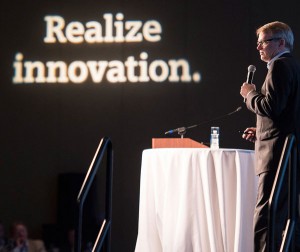 Dr. Horst J. Kayser, chief strategy officer, Siemens AG, presented the keynote focusing on digitalization: “The digital change constant.” Image courtesy of Siemens PLM Software.
Dr. Horst J. Kayser, chief strategy officer, Siemens AG, presented the keynote focusing on digitalization: “The digital change constant.” Image courtesy of Siemens PLM Software.Digital disruption equals opportunity for businesses like Siemens PLM Software and its rivals who are rushing to provide solutions that efficiently integrate design, simulation and testing more closely with manufacturing, sales and marketing, service and maintenance. Unlike its competitors, Siemens PLM Software is owned by the largest engineering company in Europe, Siemens AG. The multi-national parent company has hundreds of production and manufacturing facilities, including what it calls “lighthouse plants” in Germany and China that are highly automated. Siemens PLM Software took advantage of that expertise at this year’s Industry Analyst Conference, which took place September 8-9 in Boston, by inviting Dr. Horst J. Kayser, chief strategy officer, Siemens AG to present the opening keynote.
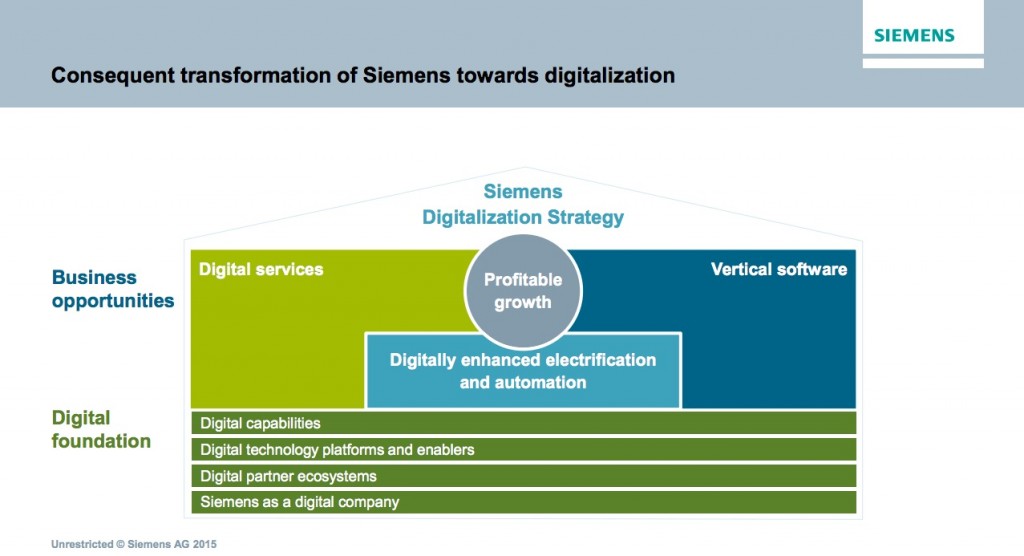 Siemens AG’s Dr. Horst Kayser used this slide to sum up the company’s digitalization strategy at the Siemens PLM Software Industry Analyst Conference 2015. Image courtesy of Siemens AG.
Siemens AG’s Dr. Horst Kayser used this slide to sum up the company’s digitalization strategy at the Siemens PLM Software Industry Analyst Conference 2015. Image courtesy of Siemens AG.Kayser’s presentation, “The Digital Change Constant,” provided an overview of the Siemens AG’s commitment to digitalization. “We put our money where our mouth is, and we’re applying digitalization technologies ourselves,” Kayser said. He noted that Siemens AG invested 4.1 billion Euros in research and development in 2014, much of which was focused on its digital technology platform and enablers.
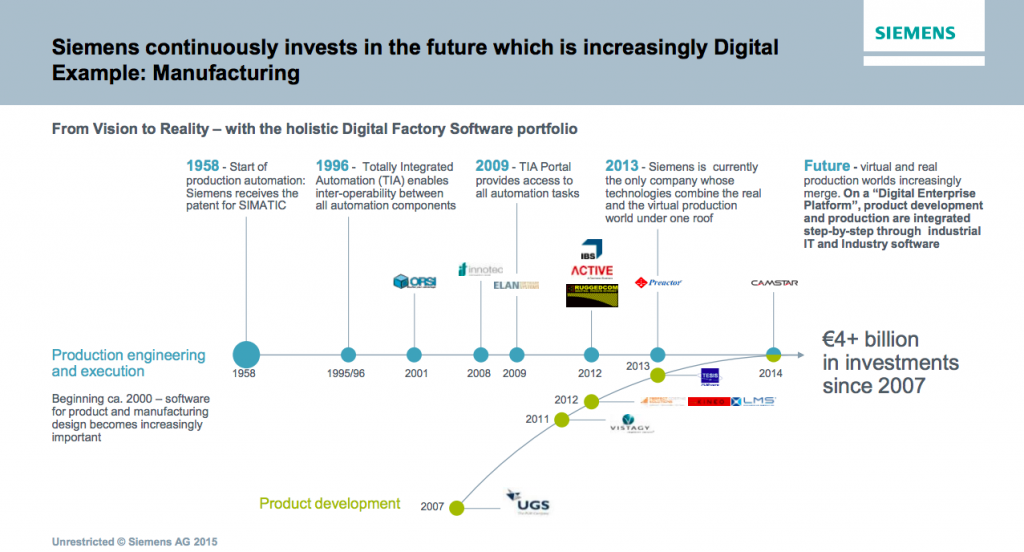 An example of how Siemens AG is integrating virtual and physical worlds in manufacturing. It acquired UGS in 2007 for $3.5 billion, which became the foundation of the Siemens PLM Software business unit. Image courtesy of Siemens AG.
An example of how Siemens AG is integrating virtual and physical worlds in manufacturing. It acquired UGS in 2007 for $3.5 billion, which became the foundation of the Siemens PLM Software business unit. Image courtesy of Siemens AG.Data-Driven Opportunities
Looking ahead, Kayser said the company is focusing on user- and machine-generated data. He said by 2020, it’s expected that there will by five times as many connected devices as people. User-generated data is already delivering billions of dollars of value to companies like Facebook, Google, LinkedIn and Airbnb, so what does that mean for the value of machine-generated data to companies that are collecting data from gas turbines, the smart grid and traffic management systems? The scale of the opportunity is clear to see.
[gallery link=“file” size=“medium” ids=”/article/virtual-desktop/wp-content/uploads/2015/09/VR.jpg|Virtual reality display at the Siemens Industry Analyst Conference 2015.,/article/virtual-desktop/wp-content/uploads/2015/09/Surface_rev.jpg|An interactive display provided information on Siemens’ solutions.,/article/virtual-desktop/wp-content/uploads/2015/09/360rev.jpg|The 360-degree Digitalization tour consisted of a robotic arm moving a display.”]
Design engineers fill a critical role on the front lines of digitalization. As Siemens PLM Software President and CEO Chuck Grindstaff said during the his keynote that kicked off the second day of the conference: “If the product development process is slow, you find yourself with a product that was great for the world three years ago.”
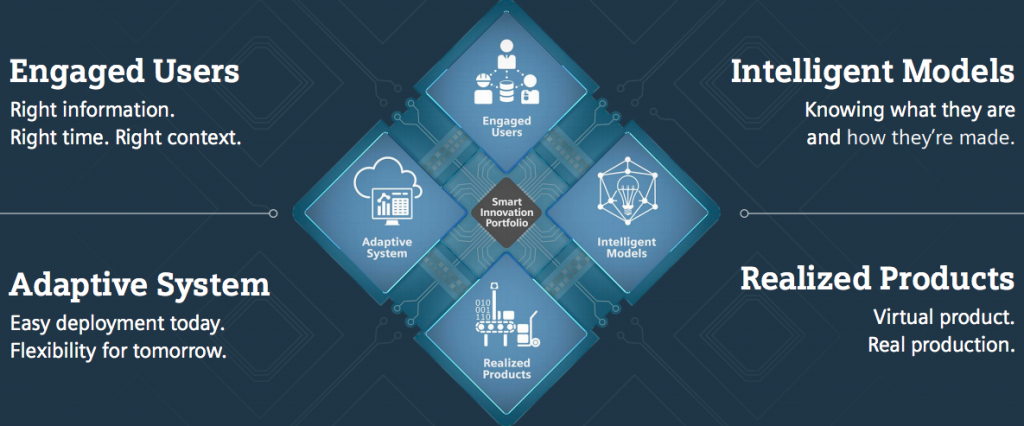 Siemens PLM Software’s Smart Innovation Portfolio encapsulates the company’s approach to digitalization. Image courtesy of Siemens PLM Software.
Siemens PLM Software’s Smart Innovation Portfolio encapsulates the company’s approach to digitalization. Image courtesy of Siemens PLM Software.To help design engineers meet the challenge of creating more complex products in less time, Grindstaff introduced what would become an oft-referred to slide of the company’s “Smart Innovation Portfolio.” According to his presentation, the Smart Innovation Portfolio consists of four segments:
- Engaged users via software that has a clear and simple user interface, provides a user experience that is customized to the work they do, and that is available any time, anywhere.
- Intelligent models that begin with accurate product simulation as the basis, but also help understand and optimize system design across mechanical and electrical engineering disciplines, so that they can be used to drive and define automated manufacturing processes.
- Realized products, which includes closing the loop between design engineers’ ideation and realization of a finished product, integrating PLM and manufacturing, leveraging Big Data for product insights and embracing advanced technologies like 3D printing, the Internet of Things (IoT), machine learning and digital twins.
- An adaptive system that is open, scalable and flexible so that it can be used by companies of various sizes across various industries.
Subsequent presentations from Siemens PLM product managers explained how Siemens PLM Software’s new Catchbook sketching app; Solid Edge design software, NX CAD, CAM and CAE software; LMS simulation and testing solutions; Omneo big data analytics platform; and Teamcenter‘s Active Workspace interface and ticked the boxes of the Smart Innovation Portfolio.
Leuridan’s closed-loop, system-driven product development strategy illustrates how LMS fits in. #splm15 pic.twitter.com/VZDchoj97Z
— Desktop Engineering (@DEeditor) September 9, 2015
However, it was the customer presentations that really brought the digitalization message home.
The Industrial Internet of Things
Konecranes calls itself “a world-leading group of Lifting Businesses.” Juha Pankakoski, chief digital officer and CIO, of the company, took the stage at the Industry Analyst Conference to explain how the company used Teamcenter as the backbone of its Industrial Internet initiative. As part of the initiative, Konecranes is collecting data from its equipment to help serve its customers and build better relationships with them. For example, it can provide customers with information on equipment life expectancy, service appointments, training that could extend equipment life and when lift trucks are idling instead of working. It’s ability to deliver such data is a significant competitive advantage over other companies trying to compete on price alone.
“Behind the Industrial Internet is an effective way to manage data in the product lifecycle, that’s what Siemens delivers,” said Pankakoski.
Konecranes is so committed to a data-driven, customer-centric future that it has launched a website called Industrial Internet Now that it describes as “a crossroads for advanced ideas and applications in industry and manufacturing.”
A significant part of Siemens PLM Software’s answer to companies who want to collect, analyze and use data to improve product development, customer service and internal operations is Omneo, which was part of Siemens’ 2014 Camstar acquisition. It is intended to be a searchable, unified data foundation that can collect and convert disparate sources of data into “product performance intelligence.” In short, it helps companies identify and use valuable data. Omneo Performance Analytics is a cloud-based, software-as-a-service application that can be added onto the Omneo base configuration for predictive analysis. For more information, read our previous coverage of Omneo here, here and here.
A Platform Approach
With the disruption that digitalization promises to bring to the enterprise, many software providers are developing platforms to allow customers to turn those disruptions into opportunities. A platform approach provides a one-stop shop for businesses who need to collaborate along all points of the product lifecycle. The risk with a platform, however, is that it is not designed to handle every situation in every industry, no matter the scale. Once it needs to be customized, that can negatively affect implementation times, future maintenance and the ability to collaboration.
Rusk: goal of “componentization” & new apps is to provide a plug-and-play platform for specialized uses of NX #splm15 pic.twitter.com/fQj6ah3eVm
— Desktop Engineering (@DEeditor) September 9, 2015
Siemens PLM Software seems to be approaching part of the platform challenge by allowing much of the functionality of its various software products to be accessed as part of its Teamcenter Active Workspace interface. It’s intended to let different types of users find what they need faster, all from a common user interface.
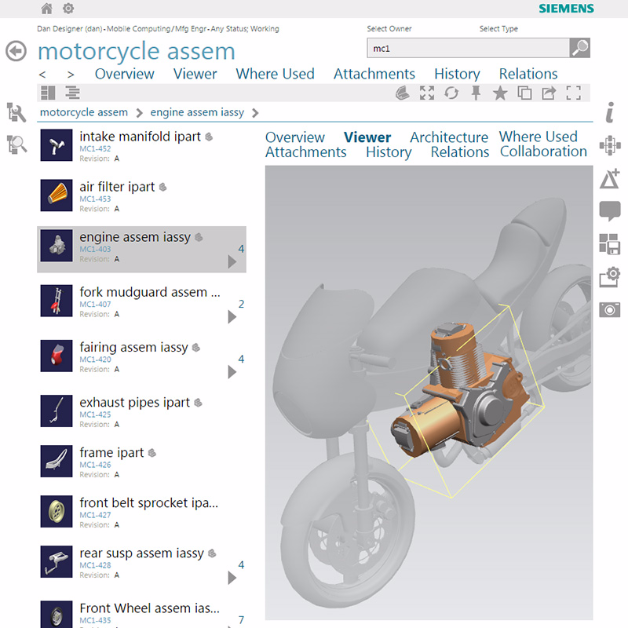 Active Workspace is designed to present you with relevant PLM information in the context of your job. Image courtesy of Siemens PLM Software.
Active Workspace is designed to present you with relevant PLM information in the context of your job. Image courtesy of Siemens PLM Software.Active Workspace featured prominently in many product presentations. It’s a big part of Siemens PLM Software’s larger efforts to reach more of the enterprise. Much like Catchbook is intended to reach those not accustomed to CAD, but still provide advanced technology under the hood, Active Workspace allows people from various points in the enterprise access information that is tailored to their needs. That type of seamless collaboration has long been a goal. It’s one more example of a technological and cultural goal that seems to be more and more within reach.
“The things we’ve talked about before in years past are now at a fundamental tipping point,” said Grindstaff as he concluded his presentation.
For one example of how digitalization sped product development, watch the video below to see how Maserati went digital with Siemens solutions.
Subscribe to our FREE magazine, FREE email newsletters or both!
About the Author
Jamie Gooch is the former editorial director of Digital Engineering.
Follow DE





